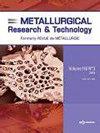The effect of casting speed on slag-inclusion defects in 1050 × 200 mm ultra-low-carbon automobile steel slabs
IF 1.1
4区 材料科学
Q3 METALLURGY & METALLURGICAL ENGINEERING
引用次数: 0
Abstract
The effect of casting speed on slag-inclusion defects in 1050 × 200 mm ultra-low-carbon automobile steel (UAS) slabs was studied by performing nail plate experiments and by monitoring the liquid level fluctuations during the continuous casting process. The number, location, length, and proportion of slag-inclusion defects in hot-rolled coils produced at different casting speeds were analyzed. The results showed that the defects in the hot-rolled coils were mainly owing to the mold protective slag. For the continuous casting speed of 1.6 m/min, the fraction of slag-inclusion defects was the lowest (at 5.3%), and the number of slag-inclusion defects was lower than for the other casting speeds. The length of slag inclusions was under 900 mm. Furthermore, the number of slag-inclusion defects on the upper and lower surfaces was smaller than those for the other casting speeds. At different casting speeds, slag-inclusion defects mainly existed within 100 mm of the edge on both surfaces of hot-rolled coil plates. The fluctuation within the 0–1 mm range was 98.1% for the casting speed of 1.6 m/min, indicating that the flow rate of molten steel on both sides of the nozzle was relatively stable, which helps to control slag-inclusion defects in hot-rolled coils.浇注速度对1050 × 200mm超低碳汽车钢板夹杂渣缺陷的影响
通过钉板试验和连续铸造过程中液面波动的监测,研究了浇注速度对1050 × 200 mm超低碳汽车钢板坯夹杂渣缺陷的影响。分析了在不同浇注速度下生产的热轧卷板夹杂渣缺陷的数量、位置、长度和比例。结果表明,热轧卷板的缺陷主要是由保护渣造成的。在1.6 m/min的连铸速度下,夹杂渣缺陷的比例最低(5.3%),夹杂渣缺陷的数量也低于其他连铸速度。夹渣长度在900 mm以下。此外,上、下表面的夹杂渣缺陷数量也比其他浇注速度下的少。在不同浇注速度下,夹杂渣缺陷主要存在于热轧卷板两侧边缘100mm以内。当浇注速度为1.6 m/min时,0 ~ 1 mm范围内波动率为98.1%,说明喷嘴两侧钢液流动相对稳定,有利于控制热轧卷板夹杂渣缺陷。
本文章由计算机程序翻译,如有差异,请以英文原文为准。
求助全文
约1分钟内获得全文
求助全文
来源期刊

Metallurgical Research & Technology
METALLURGY & METALLURGICAL ENGINEERING-
CiteScore
1.70
自引率
9.10%
发文量
65
审稿时长
4.4 months
期刊介绍:
Metallurgical Research and Technology (MRT) is a peer-reviewed bi-monthly journal publishing original high-quality research papers in areas ranging from process metallurgy to metal product properties and applications of ferrous and non-ferrous metals and alloys, including light-metals. It covers also the materials involved in the metal processing as ores, refractories and slags.
The journal is listed in the citation index Web of Science and has an Impact Factor.
It is highly concerned by the technological innovation as a support of the metallurgical industry at a time when it has to tackle severe challenges like energy, raw materials, sustainability, environment... Strengthening and enhancing the dialogue between science and industry is at the heart of the scope of MRT. This is why it welcomes manuscripts focusing on industrial practice, as well as basic metallurgical knowledge or review articles.
 求助内容:
求助内容: 应助结果提醒方式:
应助结果提醒方式:


